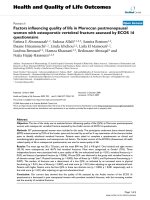báo cáo hóa học:" Measuring health-related quality of life in young adolescents: Reliability and validity in the Norwegian " doc
Bạn đang xem bản rút gọn của tài liệu. Xem và tải ngay bản đầy đủ của tài liệu tại đây (263.16 KB, 9 trang )
BioMed Central
Page 1 of 9
(page number not for citation purposes)
Health and Quality of Life Outcomes
Open Access
Research
Measuring health-related quality of life in young adolescents:
Reliability and validity in the Norwegian version of the Pediatric
Quality of Life Inventory™ 4.0 (PedsQL) generic core scales
Trude Reinfjell*
1
, Trond H Diseth
2
, Marijke Veenstra
3
and Arne Vikan
1
Address:
1
Department of Psychology, Norwegian University of Science and Technology (NTNU), N-7491, Trondheim, Norway,
2
Section of Child
and Adolescent Psychiatry, Department of Paediatrics, Rikshospitalet – Radiumhopitalet HF, N-0027 Oslo, Norway and
3
Biostatistics,
Rikshospitalet – Radiumhospitalet HF, N-0027, Oslo, Norway
Email: Trude Reinfjell* - ; Trond H Diseth - ;
Marijke Veenstra - ; Arne Vikan -
* Corresponding author
Abstract
Background: Health-Related Quality of Life (HRQOL) studies concerning children and
adolescents are a growing field of research. The Pediatric Quality of Life Inventory (PedsQL™) is
considered as a promising HRQOL instrument with the availability of age appropriate versions and
parallel forms for both child and parents. The purpose of the current study was to evaluate the
psychometric properties of the Norwegian translation of the Pediatric Quality of Life Inventory
(PedsQL™) 4.0 generic core scale in a sample of healthy young adolescents.
Methods: A cross-sectional study of 425 healthy young adolescents and 237 of their caregivers
participating as a proxy. Reliability was assessed by Cronbach's alpha. Construct validity was
assessed using exploratory factor analysis and by exploring the intercorrelations between and
among the four PedsQL subscales for adolescents and their parents.
Results: All the self-report scales and proxy-report scales showed satisfactory reliability with
Cronbach's alpha varying between 0.77 and 0.88. Factor analysis showed results comparable with
the original version, except for the Physical Health scale. On average, monotrait-multimethod
correlations were higher than multitrait-multimethod correlations. Sex differences were noted on
the emotional functioning subscale, girls reported lower HRQOL than boys.
Conclusion: The Norwegian PedsQL is a valid and reliable generic pediatric health-related Quality
of Life measurement that can be recommended for self-reports and proxy-reports for children in
the age groups ranging from 13–15 years.
Background
Mirroring a modern bio-psycho-social orientation toward
the concept of health, the development of a multidimen-
sional Health-Related Quality of Life (HRQOL) measure-
ment has been an important concern of research in recent
years. It is realized that an instrument measuring HRQOL
must consist of the physical, mental, and social health
dimensions delineated by the World Health Organization
(WHO) [1]. HRQOL studies related to children are a rela-
tively new field of research [2], still there are only a few
Published: 14 September 2006
Health and Quality of Life Outcomes 2006, 4:61 doi:10.1186/1477-7525-4-61
Received: 26 July 2006
Accepted: 14 September 2006
This article is available from: />© 2006 Reinfjell et al; licensee BioMed Central Ltd.
This is an Open Access article distributed under the terms of the Creative Commons Attribution License ( />),
which permits unrestricted use, distribution, and reproduction in any medium, provided the original work is properly cited.
Health and Quality of Life Outcomes 2006, 4:61 />Page 2 of 9
(page number not for citation purposes)
measures that assess Quality of life outcomes for children
and adolescents [3]. Such studies can have considerable
significance for understanding children's psychosocial
functioning and development like their perception of ill-
ness and its effect on their daily life [4,5]. However, the
lack of valid and reliable measures for children and ado-
lescents is one significant limitation of current HRQOL
research [6].
Issues related to young persons continuous and often
rapid developmental change were initially not sufficiently
realized [4,7]. A pediatric health-related quality of life
(HRQOL) instrument which includes a developmental
perspective must for instance show sensitivity to both cog-
nitive and emotional changes throughout the age span.
Daily functioning in contexts relevant for children, such
as school and community, should also be assessed [8].
Furthermore, a problem of these scales has been low con-
cordances between proxy-and self-reports on HRQOL
instruments. This has been observed in studies of children
in both pediatric and psychiatric population [9,10]. Con-
cordances tend to be lower for internalizing problems (eg.
depression) than for externalizing problems (eg. hyperac-
tivity) [11]. The presence of low concordance between
proxy-and self-reports suggests a critical need in pediatric
HRQOL measurement for reliable and valid child self-
report instruments for the broadest age range possible [9].
The Pediatric Quality of Life Inventory (PedsQL) [9] is
considered one of the most promising HRQOL instru-
ments for children and adolescents, integrating generic
core scales and disease-specific modules into one meas-
urement system [12].
The instrument includes a broad age range with develop-
mental sensitivity as well as categories for both parents
and the young persons themselves. The PedsQL version
4.0 builds on programmatic instrument development
research during the past 15 years, beginning with the
measurement of pain and functional status [13]. The 4.0
version was designed to measure the core health dimen-
sions delineated by WHO [1], including role (school)
functioning [9], and were developed through focus
groups and cognitive interviews [6]. The PedsQL 4.0 has
been proposed as a valid and reliable generic pediatric
HRQOL measurement that can be used for self-reports
and proxy-reports in age groups ranging from 2 to 18
years [9], and can also be used in clinical practice, clinical
trials, and research, as well as school health settings, and
community populations [7,9].
The PedsQL is translated into many European and other
international languages, and widely used in research. Ped-
sQL was translated into Norwegian during 2002/2003, at
that time no other HRQOL measurements for children
were available in Norway. When selecting a HRQOL
measure it will be important to examine its psychometric
adequacy as well as its ability to tap outcomes of primary
interest to a particular investigation [14]. The importance
of validating new translations should be emphasized to
investigate the acceptability of the psychometric proper-
ties for further use in both clinical practice and research.
This first validation study of the PedsQL Norwegian ver-
sion is a pilot study with young adolescents, and is part of
a larger study with a broader focus on young adolescent's
quality of life and mental health.
The objective of the current paper was to evaluate reliabil-
ity and validity of the Norwegian translation of the Ped-
sQL™ (version 4.0 generic core scale) in a sample of
healthy young adolescents. The focus in the present paper
is therefore on the scales that are relevant for adolescents.
Methods
Participants
A sample of 440 young adolescents and their parents were
recruited through five junior high schools in Norway,
three from urban and two from rural areas. A total of 440
questionnaires were distributed and 425 were returned,
which gives a response rate of 96.6%.
Self-report forms were completed by 425 adolescents, 235
girls (56%) and 184 boys (44%), six did not report gen-
der. In junior high schools in Norway adolescents
between 13 to 15 years of age are separated in three differ-
ent grades and participants were distributed as follows for
8
th
, 9
th
and 10
th
grade; 33%, 33%, 34%, respectively.
Proxy-reports were completed by 237 (56%) caregivers.
The proxy-reports were completed by 139 (59%) mothers,
by both parents in 69 (29%) of the cases, by 27 (11%)
fathers, or by other caregivers such as grandparents 2
(0.8%). For 229 adolescents both adolescent self-report
and parent proxy-report on the PedsQL were available.
Information about non-response in the sample of adoles-
cents as well as the sample of parents was not available,
because of the anonymity required. Sociodemographic
characteristics of the sample are given in Table 1. The Data
Inspectorate and the Regional Committee for Medical
Research Ethics approved the study. Written parental
informed consent and child assent were obtained.
Measures
The 23-item PedsQL, version 4.0 Generic Core Scales, can
be grouped into 4 domains of HRQOL: 1) Physical Func-
tioning (8 items), 2) Emotional Functioning (5 items), 3)
Social Functioning (5 items) and 4) School Functioning
(5 items). These scales are feasible for child self-report
including ages 5 to 7, 8 to 12 and 13 to 18 years. Parent
Health and Quality of Life Outcomes 2006, 4:61 />Page 3 of 9
(page number not for citation purposes)
proxy-report includes ages 2 to 4, 5 to 7, 8 to 12 and 13 to
18, and assesses parent's perceptions of their child's
HRQOL.
The items for self-report and proxy-report are essentially
identical, differing in developmentally appropriate lan-
guage, and first or third person tense. The instructions ask
how much of a problem each item has been during the
past 1 month. A 5-point response scale is utilized across
child self-report for ages 8 – 18 and parent proxy-report (0
= never a problem; 1= almost never a problem; 2 = some-
times a problem; 3 = often a problem; 4 = almost always
a problem). Subjects are requested to rate how much
problems they experienced during the past month with
health (eg. "I hurt or ache"), activities (eg. "It's hard for
me to run"), or feelings (eg. "I feel afraid or scared").
Items are reverse-scored and linearly transformed to a 0 to
100 scale (0 = 100, 1 = 75, 2 = 50, 3 = 25, 4 = 0), so that
higher scores indicate better HRQOL. Scale scores are
computed as the sum of the items divided by the number
of items answered (this accounts for missing data). In
addition to the four subscales, two summary scores can be
computed. Physical Health Summary score (8 items) is
the same as the Physical Functioning subscale, and Psy-
chosocial Health Summary score (15 items) is computed
as the sum of the items divided by the number of items
answered in the Emotional, Social, and School Function-
ing subscales.
The translation and linguistic validation of the PedsQL
questionnaire followed recommended guidelines [15,16].
Two independent forward translations were conducted by
a psychiatrist and a clinical psychologist, the translators
discussed semantic and conceptual discrepancies and
finally developed a consensus forward translation. The
translation of the first reconciled forward version of the
PedsQL questionnaire back into the source language was
done by a skilled english speaking person with experience
from living in English speaking countries.
In a following pilot-project, the questionnaire was admin-
istrated to 10 children, 12 adolescents and 23 parents to
test the interpretation and understanding of items and
response ratings. Cognitive interview techniques [15]
were used to obtain feedback about the interpretation and
understanding of items and respons ratings. The question-
naires were then revised in response to feedback from
children and parents. A written report was sent to Varni
for further review. The relevant changes in the translation
process were reviewed and authorised by Varni. In addi-
tion to the PedsQL 4.0, the questionnaires included infor-
mation about children's socio-demographic
characteristics.
Procedure
Local junior high schools were contacted and teachers dis-
tributed written consent forms that the adolescents pre-
sented to their parents. Each pupil received an envelope,
which contained information and a questionnaire for
their parents. Parents were asked to return the completed
questionnaire in a pre-stamped envelope. The participants
could further contact the researchers to obtain additional
information. Approvals signed by the parents and
returned to the teacher, confirmed that the adolescent had
permission to participate.
The self-report instruments were administrated and com-
pleted in the classrooms. Children were given verbal and
written information before completing questionnaires in
class, under the supervision of a research assistant.
Statistical analysis
Scale internal consistency reliability was determined by
calculating Cronbach's alpha coefficient [17]. Scales with
reliabilities equal to or greater than 0.70 were considered
satisfactory and are also recommended for comparing
patient groups [18,19].
We used exploratory factor analysis to examine the struc-
ture of relationships between the items of the PedsQL™
Table 1: Sociodemographic characteristics of 419 adolescents
and their parents
Adolescents N %
Total sample 419
Girls 235 56.1
Boys 184 43.9
School grade:
8
th
grade 140 32.9
9
th
grade 142 33.4
10
th
grade 143 33.7
Parental education and economy
Mothers 216
Mothers education:
Elementary school 10 4.7
Highschool graduate 51 23.6
Post high school 155 71.7
Fathers 110
Fathers education:
Elementary school 5 4.4
Highschool graduate 25 22.8
Post high school 80 72.8
Economy 235
Very satisfying 26 11.1
Good 198 84.2
Poor 11 4.7
Health and Quality of Life Outcomes 2006, 4:61 />Page 4 of 9
(page number not for citation purposes)
4.0 and to compare the factor structure in the present
study with the structure reported for the original PedsQL™
[9]. Regarding Varni's results where the school function-
ing items loaded on two separate factors, we expected to
find a five factor structure. To extract the factors we
applied Principal Component Analysis, with oblique rota-
tion (Direct Oblimin). Factors with an eigenvalue less
than 1 were disregarded.
Validity was further examined by exploring the intercorre-
lations between and among the four PedsQL Subscales
[20]. To strengthen faith in the validity of the PedsQL ver-
sion 4.0, multitrait-monomethod correlations (eg. corre-
lations among subscales within self-report and proxy-
report) should be lower than monotrait-multimethod
correlations (eg. concordance between self-report and
proxy-report for the same subscale). Correlations are des-
ignated as small (0.10–0.29), medium (0.30–0.49), and
large (=0.50) [21]. Given shared method variance [18]
and that the PedsQL items were developed to measure an
integrated multidimensional construct (pediatric
HRQOL), it was expected that heterotrait-monomethod
correlations among the Subscales would be medium to
large (0.30–0.50). Proxy/child concordance for the same
subscale was furthermore expected to demonstrate
medium to large effect sizes.
Based on previous literature [9] it was anticipated that the
Physical Functioning Subscale would demonstrate the
largest concordance, and heterotrait-heteromethod con-
cordance was expected to be small. In addition, we calcu-
lated intraclass correlation coefficients (ICC) to assess
parent and child convergence on the PedsQL subscales.
ICC takes into account not only the correlation but also
differences in intercept and slope between replicant rat-
ings [22]. Paired t-test were used to assess the extend to
which adolescents or proxies systematically scored lower
on the subscales of the PedsQL. As a measure of the min-
imally important difference in scores, we calculated the
standardized response mean, a distribution-based
approach that compares temporal change by the standard
deviation of change [21]. Standardized response mean of
0.2–0.5, 0.5–0.8, and >0.8 are regarded as small, moder-
ate, and large, respectively. Gender differences in the self-
report scales were analysed with two-sample t-test. For all
analyses, we used SPSS statistical software version 12.0
(SPSS Inc., Chicago, III, USA) and a critical value (α) of
5%.
Results
Scale-level analysis
Mean scale scores, percentage of scores at the floor and
ceiling and Cronbach's alpha are shown in Table 2. All the
self-report scales and proxy-report scales exceeded the
minimum reliability standard of 0.70. No floor effects
were found on self or proxy-report for this healthy sample
of adolescence. Ceiling effects existed and ranged from
minimal (eg. 2.6% and 3.4% for self and proxy-report,
respectively for Total score) to moderate (eg. 26.5% and
24.2% for self and proxy-report for Physical Functioning).
The largest effect was found for Social Functioning (43%
and 46% for self and proxy-report). Table 2 gives informa-
tion about scale descriptives and internal consistency reli-
ability for the PedsQL 4.0.
Further, for all 23 items, item means for self-report ranged
from 67.9 to 99.9 with 12 of 23 items falling within a 10-
point range. Item means for proxy report ranged from
67.8 to 98.9, with 13 items falling within a 10-point
range. Two items from the Physical health scale have a rel-
atively small standard deviation namely: 1.2 (item 5) and
9.6 (item 1) for the self-report, 8.2 (item 5) and 8.8 (item
1) for the proxy report. The remaining standard deviations
ranged from 13.3 to 25.8 for self-report items and 14.8 to
23.7 for proxy-report items.
Construct validity
Adolescent-parent report
Monotrait-multimethod correlations are all statistically
significant but generally modest. Table 3 shows the inter-
correlations between and among the four subscales of the
PedsQL.
For the subscale School Functioning we found moderate
(>0.40) intercorrelations between adolescents and par-
ents. All multitrait-multimethod correlations were lower
than the monotrait-multimethod correlations. However,
some of the multitrait-multimethod correlations are
higher than the convergent correlations of the other three
subscales, in particular for Emotional functioning and
Social functioning. The average convergent correlation is
0.31 and the average off-diagonal correlation is 0.22. This
indicates that on average the monotrait-multimethod cor-
relations are higher than the multitrait-multimethod cor-
relations. The intraclass-correlation (ICC) was relatively
low for all scales, indicating poor to fair (<0.40) child-
proxy agreement for all scales but one. Moderate agree-
ment (ICC = 0.41) was found for the sub scale measuring
School functioning. Lowest agreement was found for the
emotional functioning scale (ICC = 0.21). The results of
the paired t-tests suggested that parents scores were sys-
tematically higher than that of adolescents for Emotional
functioning (t = 2.32; df = 228; p = 0.02) and School func-
tioning (t = -5.28; df = 228; p < 0.001). Conversely, par-
ents reported lower on the subscales for Physical
functioning (t = 2.9; df = 233; p = 0.004) and Psychosocial
health scale (t = -2.7; df = 231; p = 0.007). The scores on
the Social Functioning scale did not yield statistically sig-
nificant differences between parents and adolescents (t =
1; df = 228; p = 0.268). Only the difference found for
Health and Quality of Life Outcomes 2006, 4:61 />Page 5 of 9
(page number not for citation purposes)
School Functioning corresponded to a small effect size
(0.35), the other differences between parents and adoles-
cents all have effect sizes below 0.20.
Gender differences
A statistically significant gender differences was found on
the emotional subscale, with girls on average scoring
lower than boys (t = 4,79; df = 416, p < 0.001). However,
the mean score for girls (73.92 and sd = 17.53) as well as
for boys (81.85 and sd = 15.83) were at the high end of
the scale. No statistically significant gender differences
were found for the remaining scales.
Factor analysis
The results of the factor analysis for self-report and proxy-
report are shown in table 4 and 5.
An eigenvalue cutoff of 1.0 resulted in a five factor solu-
tion for self-report and proxy-report, accounting for 56 %
and 61 % of the variance. The school functioning items
split into two different factors, like the originally version.
For physical functioning, item 5 ("hard to take bath or
shower"), item 6 ("hard to do chores around the house")
and item 7 ("hurth or arche") split into different factors.
The items related to emotional and social functioning are
consistent with the original PedsQL™ version [23].
Discussion
This article describes the psychometric properties of the
Norwegian translation of the PedsQL™ 4.0 generic core
scale in a healthy sample of young adolescents and their
caregivers. The results from the present study resemble the
findings of the original PedsQL™ [9] and the UK-English
version [24] and as such confirm that the instrument can
be used for self-reports and proxy-reports in school health
settings and community populations.
Reliability
Internal consistency was satisfactory with Cronbach's alph
coefficient >0.70 for all four subscales. No floor effects
were found for any of the scales. The presence of ceiling
effects in the present study may be expected in generic
HRQOL instruments, because they are made to be appli-
cable to a wide range of populations [24]. This could be a
Table 3: Intercorrelations between and among PedsQL subscales
Adolescent self-report Parent proxy-report
Adolescent self-report 1234567
1 Physical functioning
2 Emotional functioning 0,65
3 Social functioning 0,66 0,61
4 School functioning 0,56 0,54 0,46
Parent proxy-report
5 Physical functioning 0,35
0,12
ns
0,21 0,35
6 Emotional functioning 0,25 0,22
0,29 0,30 0,52
7 Social functioning 0,20 0,12
ns
0,28 0,25 0,51 0,50
8 School functioning 0,17 0,15 0,19 0,42
0,53 0,54 0,49
Notes: N = 229; NS = Not significant at 5% level; Multitrait-monomethod correlations are in bold; monotrait-multimethod correlations are
underlined; multitrait-multimethod correlations are italicised.
Table 2: Scale Descriptives and Internal Consistency Reliability for PedsQL 4.0
Scale Items N Mean SD Percentage floor Percentage ceiling Cronbach's alpha
Adolescent self-report
Total score 23 414 85.29 11.11 0 2.6 .84
Physical health 8 422 91.12 10.35 0 26.5 .78
Psychosocial health 15 416 82.16 12.50 0 3.1 .82
Emotional functioning 5 424 77.15 17.32 0 10.4 .79
Social functioning 5 424 88.12 13.11 0 43.6 .80
School functioning 5 424 78.02 15.47 0 8.3 .73
Parent proxy-report
Total score 23 232 86.10 10.20 0 3.4 .77
Physical health 8 236 88.83 11.76 0 24.2 .80
Psychosocial health 15 234 84.66 10.92 0 4.3 .88
Emotional functioning 5 238 79.98 14.13 0 12.7 .78
Social functioning 5 238 88.05 13.37 0 46.0 .82
School functioning 5 238 88.97 12.37 0 13.5 .75
Health and Quality of Life Outcomes 2006, 4:61 />Page 6 of 9
(page number not for citation purposes)
sample specific phenomenon, and should be further
explored through the administration of PedsQL™ to chil-
dren with different health issues including those children
and adolescents experiencing acute health problems.
Regarding single item descriptives, it is interesting to note
the low standard deviation for two items from the Physi-
cal health scale. These results are challenging the require-
ments of equivalent item means and variance. However,
this finding may be typical for the way PedsQL behaves in
a healthy sample.
Validity
Our results showed that on average the monotrait-multi-
method correlations are higher than the multitrait-multi-
method correlations. This high multitrait-multimethod
correlations indicate that the different traits measured in
the four subscales show considerable overlap. For exam-
ple, three items in the physical functioning scale ("hard to
take bath or shower", "hard to do chores around the
house", and "hurt or ache") are loading on another factor
than the other physical functioning items. This could be
more related to a fatigue component, which seems more
relevant for a chronically ill patient population than
healthy adolescents. A confirmatory factor analysis could
provide further insight in the degree of overlap between
items hypothesized to measure different constructs, and
also in the equivalence of factor loadings on the items
within a single factor.
The adolescent-parent agreement did not exceed the pre-
ferred intra-class correlation of 0.40, except for the scale
measuring School function. Lack of agreement between
parents and children may result from differences in per-
ception of the same situation, and also differences in
interpretation of different items [11], or may be due to the
young adolescents becoming more independent from the
parents. As opposed to some previous research [25], our
findings did not find higher agreement between parents
and adolescents regarding physical problems. Parents
rated the physical function scale lower than their chil-
dren's reports. Further, a recent study found that proxy
and self-report correlation was higher for children with
health problems than for healthy children [24]. Parents
and children may be more likely to share information
about an issue if it is perceived as a problem [24]. How-
ever, the strength of this agreement has also been chal-
lenged in research on children with Cystic Fibrosis [8].
Table 4: PedsQL 4.0 Norwegian version Factor Loadings for Adolescents Self-Report
Scale/Item Factor 1 Factor 2 Factor 3 Factor 4 Factor 5
Physical Functioning
1. Hard to walk more than one block ,079 ,702 -,356 ,086 ,299
2. Hard to run ,327 ,887 -,359 ,145 ,270
3. Hard to do sports or exercises ,375 ,851 -,322 ,142 ,240
4. Hard to lift something heavy ,251 ,568 -,484 ,052 ,363
5. Hard to take bath or shower -,036 ,039 ,041 ,509 -,195
6. Hard to do chores around house ,497 ,255 -,363 -,008 ,421
7. Hurth or arche ,562 ,460 -,441 ,229 ,436
8. Low energy ,531 ,595 -,474 ,131 ,371
Emotional Functioning
1. Feel afraid or scared ,723 ,344 -,479 ,183 ,323
2. Feel sad or blue ,799 ,419 -,385 ,092 ,387
3. Feel angry ,742 ,210 -,363 ,027 ,418
4. Trouble sleeping ,553 ,301 -,249 ,182 ,305
5. Worry about what will happen ,641 ,387 -,492 ,035 ,489
Social Functioning
1. Trouble getting along w/peers ,500 ,349 -,730 ,032 ,219
2. Other kids not wanting to be friend ,481 ,369 -,770 ,164 ,213
3. Teased ,450 ,299 -,583 ,163 ,161
4. Doing things other peers do ,201 ,401 -,772 ,061 ,341
5. Hard to keep up when play with others ,247 ,400 -,799 ,019 ,412
School Functioning
1. Hard to concentrate ,377 ,326 -,341 ,129 ,825
2. Forget things ,435 ,335 -,330 ,024 ,799
3. Trouble keeping up with schoolwork ,418 ,387 -,317 ,100 ,825
4. Miss school – not well ,462 ,287 -,161 ,571 ,286
5. Miss school – doctor appointment ,109 ,105 -,163 ,791 ,251
Eigenvalue cutoff: 1.0; Total Variance Explained for Adolescents Self-Report: 57%; Bold = highest factor loading for each item.
Health and Quality of Life Outcomes 2006, 4:61 />Page 7 of 9
(page number not for citation purposes)
Another explanation for the low concordance between
adolescents and parents regarding physical functioning
can be seen in the factor analysis (table 4 and 5) which
indicated that items concerning physical functioning (5,
6, 7) were rather diffuse components related to physical as
well as emotional domains, and therefore difficult to dis-
tinguish, something that could further influence both
adolescents and parents ratings. Children reported lower
HRQOL on the emotional scale compared with their par-
ents, and corresponds to the previous research of Modi &
Quittner [8]. Young children may have difficulty express-
ing their emotions directly to their parents, another factor
could be the likeliness that proxy-report reflect parental
anxiety about their child [24]. This aspect should be fur-
ther investigated in different patient populations, and
confirms the need to measure both child and parent per-
spectives when evaluating HRQOL. Clinically, those dis-
crepancies give a potential for interventions emphasizing
the children's subjective ratings, as well as their parents
[8,11].
Regarding gender differences, we found that girls reported
lower levels of emotional functioning than boys. This is
consistent with previous research regarding gender differ-
ences in emotional health [26-28]. The gender differences
would seem to reflect a genuine disparity between boys
and girls and therefore gives further evidence for the valid-
ity of PedsQL™ as a sensitive measure of the emotional
functioning of children and adolescents [24].
The result of the factor analysis resembles Varni's five-fac-
tor structure in the original PedsQL™ version, except for
some items. Like the results of Varni et al. [9] two of the
five items (4 and 5) related to school functioning were
loading to another factor. A natural explanation for this
could be that the three first items related to school func-
tioning (eg. "hard to concentrate", "forget things", "trou-
ble keeping up with schoolwork") are more likely to have
a cognitive component, while the others are more related
to physical aspects (eg. "miss school because not feeling
well", "miss school because of doctor appointment").
All items related to social functioning had a clear factor
loading, as well as the items related to emotional func-
tioning. The physical items seem to split into three factor
loadings (see Table 4). Item 1 ("hard to walk more than a
block"), item 2 ("hard to run"), item 3 ("hard to do sports
or exercises"), item 4 ("hard to lift something heavy") and
item 8 ("low energy") are all loading on factor 2. Further,
item 6 ("hard to do chores around the house", item 7
Table 5: PedsQL 4.0 Norwegian version Factor Loadings for Parent Proxy-Report
Scale/Item Factor 1 Factor 2 Factor 3 Factor 4 Factor 5
Physical Functioning
1. Hard to walk more than one block ,151 ,808 -,143 ,190 -,263
2. Hard to run ,322 ,816 -,364 ,305 -,149
3. Hard to do sports or exercises ,302 ,812 -,392 ,326 -,196
4. Hard to lift something heavy ,230 ,774 -,260 ,225 -,253
5. Hard to take bath or shower ,003 ,687 -,152 ,196 -,210
6. Hard to do chores around house ,052 ,309 -,272 ,291 -,738
7. Hurth or arche ,491 ,339 -,202 ,279 -,664
8. Low energy ,428 ,421 -,426 ,384 -,692
Emotional Functioning
1. Feel afraid or scared ,775 ,187 -,281 ,294 -,263
2. Feel sad or blue ,716 ,338 -,471 ,367 -,411
3. Feel angry ,597 ,166 -,293 ,420 -,387
4. Trouble sleeping ,680 ,158 -,159 ,180 -,112
5. Worry about what will happen ,715 ,344 -,432 ,391 -,141
Social Functioning
1. Trouble getting along w/peers ,327 ,316 -,833 ,279 -,259
2. Other kids not wanting to be friend ,337 ,231 -,905 ,358 -,118
3. Teased ,237 ,277 -,776 ,359 -,169
4. Doing things other peers do ,241 ,530 -,618 ,462 -,013
5. Hard to keep up when play with others ,170 ,359 -,545 ,618 ,026
School Functioning
1. Hard to concentrate ,321 ,278 -,296 ,852 -,222
2. Forget things ,222 ,267 -,222 ,761 -,370
3. Trouble keeping up with schoolwork ,363 ,207 -,369 ,841 -,214
4. Miss school – not well ,408 ,250 -,108 ,352 -,661
5. Miss school – doctor appointment ,386 ,147 -,135 ,348 -,263
Eigenvalue cutoff: 1.0; Total Variance Explained for Proxy-Report: 60%; Bold = highest factor loading for each item.
Health and Quality of Life Outcomes 2006, 4:61 />Page 8 of 9
(page number not for citation purposes)
("hurth or arche") on factor 1. Item 5 ("hard to take bath
or shower") on factor 4. In the results of Varni et al. [9] the
loading for the four first items for the physical functioning
scale is similar to our results. The factor loadings for the
proxy-report also indicate that the physical factor loadings
seem to have the same pattern, most of the factor loadings
are similar to the child self-report. It should be pointed
that comparisons to the factor structure obtained in the
original PedsQL™ publication may be restricted and less
comparable due to the restricted age range in this present
study. The restricted age range, with a healthy population,
may attenuate the variability achieved. The results from
the factor analysis regarding item 5, 6 and 7 in the Physi-
cal Functioning scale, as well as items 4 and 5 in the
School Function scale may be typically for healthy sam-
ples, the factor structure should therefore be reinvesti-
gated in clinical samples.
Limitations
Concerning the Norwegian PedsQL™ 4.0 validation study,
the present findings have several potential limitations.
Test-retest reliability and responsiveness are not reported.
Information on non-participants was not available, some-
thing that can limit generalizability. In the American vali-
dation study, the PedsQL differentiated HRQOL between
healthy children and children with acute or chronic health
conditions. This will also be an important future goal to
investigate for the Norwegian PedsQL version, and is
something the authors are taking into consideration. In
this study the age range utilized was quite restricted.
Regarding developmental aspects, further research should
investigate the Norwegian PedsQL versions' psychometric
properties concerning the upper-age range which the ado-
lescent PedsQL was made for, as well as younger age-
groups.
Conclusion
The PedsQL Norwegian version is generally a valid and
reliable instrument, replicating some of the earlier find-
ings for the originally version. The Norwegian PedsQL™
4.0 version will be a valuable tool for assessing the
HRQOL of young adolescents in Norway.
The imperfect concordance observed between self-and
proxy-reports supports the need to measure the perspec-
tives of child and parent in evaluating pediatric HRQOL
[9,29]. It would be important emphasizing the clinically
usefulness regarding child-parent discrepancies still when
challenging the validity of measures.
Competing interests
The author(s) declare that they have no competing inter-
ests.
Authors' contributions
TR made contribution to the study design, data collection,
statistical analysis, interpretation of data and the drafting
of the paper. THD contributed to the study design, inter-
pretation of the data, drafting and revising the manu-
script. MV contributed to the statistical analysis,
interpretation of the data and manuscript drafting. AV has
contributed the interpretation of the data and manuscript
drafting. All authors read and approved the final manu-
script.
Acknowledgements
We would like to thank prof. Varni for permission to use the PedsQL™ 4.0
generic core scale, and for his valuable help with the translation of the Ped-
sQL™ to Norwegian. We are very grateful to all the schools, adolescents
and their parents who willingly took part in this study. This research was
supported by the Department of Psychology, Norwegian University of Sci-
ence and Technology (NTNU).
References
1. WHO: Constitution of the World Health Organization basic
document. World Health Organization; 1948.
2. Calaminus G, Weinspach S, Teske C, Gobel U: Quality of life in
children and adolescents with cancer. Klin Padiatr 2000,
212(4):211-215.
3. Bullinger M, Ravens-Sieberer U: Grundlagen, Methoden und
Anwendungsgebiete der Lebenqualitetsforschung bei
Kindern (General principles, methods and areas of applica-
tion of Quality of Life research in children). Prax Kinderpsychol
Kinderpsychiatr 1995, 44:391-399.
4. Eiser C, Morse R: The measurement of quality of life in chil-
dren: Past and future perspectives. J Dev Behav Pediatr 2001,
22(4):248-256.
5. Noll RB, Garstein MA, Vannatta K, Corell J, Bukowski WM, Davis
WH: Social, emotional and behavioural functioning of chil-
dren with cancer. Pediatrics 1999, 103:71-78.
6. Varni JW, Seid M, Rode CA: The PedsQL (TM): Measurement
model for the pediatric quality of life inventory. Med Care
1999, 37(2):126-139.
7. Koot HM, Wallander JL: Quality of life in child and adolescent
illness, concept, methods and findings. Brunner-Routledge;
1999.
8. Modi AC, Quittner AL: Validation of a disease-specific measure
of health-related quality of life for children with cystic fibro-
sis. J Pediatr Psychol 2003, 28(8):535-545.
9. Varni JW, Seid M, Kurtin PS: PedsQL (TM) 4.0: Reliability and
validity of the pediatric quality of life Inventory (TM) Version
4.0 generic core scales in healthy and patient populations.
Med Care 2001, 39(8):800-812.
10. Berg-Nielsen TS, Vika A, Dahl AA: When adolescents disagree
with their mothers: CBCL-YSR discrepancies related to
maternal depression and adolescent self-esteem. Child Care
Health Dev 2003, 29(3):207-213.
11. Vance YH, Morse RC, Jenney ME, Eiser C: Issues in measuring
quality of life in childhood cancer: Measures, proxies, and
parental mental health. J Child Psychol Psychiatry 2001,
42(5):661-667.
12. Upton P, Eiser C, Cheung I, Hutchings HA, Jenney M, Maddocks A,
Russel IT, Williams JG: Measurement properties of the UK-Eng-
lish version of the Pediatric Quality of Life Inventory 4.0
(PedsQL) Generic Core Scales. Health Qual Life Outcomes 2005,
3:22.
13. Varni JW, Thompson KL, Hanson V: The Varni Thompson Pedi-
atric Pain Questionnaire .1. Chronic Musculoskeletal Pain in
Juvenile Rheumatoid-Arthritis. Pain 1987, 28(1):27-38.
14. Spieth LE: Generic health-related quality of life measures for
children and adolescents. In Quality of life in child and adolescent
illness, concepts, methods and findings (ss 49–88) Edited by: Koot HM.
Wallander JL: Brunner-Routledge; 2001.
Publish with BioMed Central and every
scientist can read your work free of charge
"BioMed Central will be the most significant development for
disseminating the results of biomedical researc h in our lifetime."
Sir Paul Nurse, Cancer Research UK
Your research papers will be:
available free of charge to the entire biomedical community
peer reviewed and published immediately upon acceptance
cited in PubMed and archived on PubMed Central
yours — you keep the copyright
Submit your manuscript here:
/>BioMedcentral
Health and Quality of Life Outcomes 2006, 4:61 />Page 9 of 9
(page number not for citation purposes)
15. Quittner AL, Sweeny S, Watrous M, Munzenberger P, Bearss K, Nitza
AG, Fisher LA, Henry B: Translation and linguistic validation of
a disease-specific quality of life measure for cystic fibrosis. J
Pediatr Psychol 2000, 25(6):403-414.
16. Varni J: PedsQLTM Translation methodology. 1998 [http://
www.pedsql.org].
17. Cronbach LJ: Coefficient Alpha and the Internal Structure of
Tests. Psychometrika 1951, 16(3):297-334.
18. Pedhazur EJ, Schmelkin LP: Measurement, design, and analysis:
An integrated approach. Hillsdale NJ Erlbaum; 1991.
19. Nunnally JC, Bernstein IR: Psychometric theory. 3rd edition. New
York NY: McGraw-Hill; 1994.
20. Lewis-Bech MS: Basic Measurment. Volume 4. London: SAGE Pub-
lications; 1994.
21. Cohen J: Statistical power analysis for the behavioural sci-
ences. New York: Academic Press; 1988.
22. Streiner DL, Norman NR: Health measurment scales: a practi-
cal guide to their development and use. Oxford University
Press; 1995.
23. Varni JW, Brown J, Seid M, Szer IS: Health-related quality of life
in children and adolescents with Fibromyalgia. Arthritis and
Rheumatism 2001, 44(9):S381-S381.
24. Upton P, Maddocks A, Eiser C, Barnes PM, Williams J: Development
of a measure of the health-related quality of life of children
in public care. Child Care Health Dev 2005, 31(4):409-415.
25. Landgraf J, Abetz L, Ware J: Child Health Questionnaire (CHQ):
A user's manual. Boston: The Health Institute New England Med-
ical Center; 1996.
26. Rosenfield S, Vertefuille J, McAlpine DD: Gender stratification
and mental health: An exploration of dimensions of the self.
Soc Psychol Q 2000, 63(3):208-223.
27. Avison WR, Mcalpine DD: Gender Differences in Symptoms of
Depression among Adolescents. J Health Soc Behav 1992,
33(2):77-96.
28. Compas BE, Orosan PG, Grant KE: Adolescent Stress and Cop-
ing – Implications for Psychopathology during Adolescence.
J Adolesc 1993, 16(3):331-349.
29. Eiser C, Morse R: Can parents rate their child's health-related
quality of life? Results of a systematic review. Qual Life Res
2001, 10(4):347-357.









